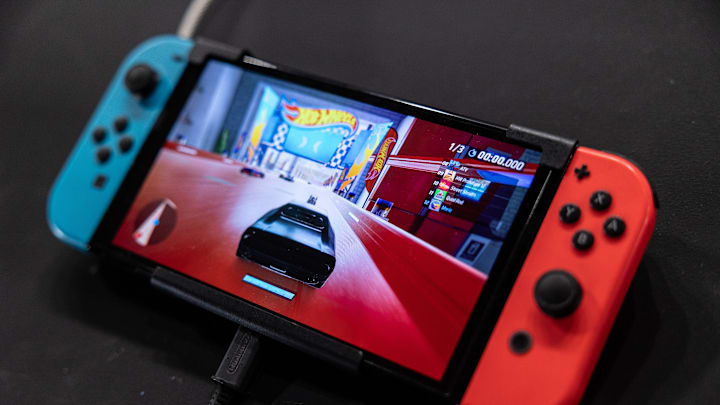Nintendo's ambitious plan to manufacture 10 million units of the rumored Switch 2 in the next fiscal year has significant implications for the gaming industry. The move signals Nintendo's proactive approach to addressing supply chain challenges, a common hurdle faced by new console releases. Unlike the scarcity issues experienced by the PlayStation 5 and Xbox Series X/S for over two years post-launch, Nintendo aims to ensure a smoother availability of its anticipated successor.
According to Bloomberg reporter Takashi Mochizuki, data related to "amusement display" (how physical retailers showcase specific products) based on supply chain forecasts suggests Nintendo's commitment to meeting high demand. The 10 million unit target for the Switch 2's first fiscal year on the market reflects Nintendo's determination to avoid the supply shortages that have plagued previous console releases.
The time frame for the rollout of these units remains uncertain, as Nintendo's fiscal year concludes in March 2025, and the exact launch date for the Switch 2 is yet to be confirmed. Reports suggest a potential release in the second half of 2024, but official confirmation from Nintendo is pending. The rapid production and distribution of 10 million units within a short time frame could position the Switch 2 favorably compared to its competitors.
Bloomberg's report also sheds light on the expected features of the Switch 2, including an 8-inch LCD screen, a departure from the OLED display in the current Switch. While the larger screen size may appeal to consumers, the reported compromise on picture quality underscores Nintendo's strategic focus on cost-effectiveness. Additionally, early reports suggest that the Switch 2 may not match the power of the PS5 or Xbox Series X/S, aligning with Nintendo's historical approach of offering unique features rather than raw processing power.
Nintendo's move to ensure a robust supply of the Switch 2 indicates a commitment to meeting consumer demand and avoiding the challenges faced by competitors in the past. As the gaming community eagerly anticipates the next console release, Nintendo's approach may set a precedent for addressing supply issues in the highly competitive console market.
Nintendo's proactive strategy to produce 10 million Switch 2 units in the initial fiscal year represents a departure from the industry norm, where supply constraints often lead to prolonged scarcity and waiting lists for new consoles. The move could potentially redefine the narrative surrounding console launches and reshape consumer expectations regarding availability.
The success of this ambitious manufacturing goal hinges on the timing of the Switch 2's launch, which is yet to be officially disclosed by Nintendo. If the console hits the market between November and March, as per the fiscal year timeline, the rapid availability of 10 million units could outpace the yearly sales of competitors like the PS5. However, if the launch occurs earlier, such as in July, the units may be spread across a more extended period, potentially leading to intermittent scarcity.
Bloomberg's report highlighting the Switch 2's expected features, including an 8-inch LCD screen, underscores Nintendo's strategic choices. Opting for a larger yet cost-effective screen, albeit with a potential compromise on picture quality compared to OLED, aligns with Nintendo's tradition of providing unique features that set its consoles apart.
Despite reports suggesting that the Switch 2 may not match the processing power of its rivals, Nintendo's emphasis on distinctive features has historically resonated with consumers. The success of the Wii's motion controls and the Switch's portability serves as a testament to Nintendo's ability to innovate and cater to a diverse gaming audience.
As the gaming community eagerly awaits official announcements and the potential launch of the Switch 2, Nintendo's bold manufacturing strategy could pave the way for a new era in console releases. The industry will be closely watching to see how this approach shapes consumer experiences, addresses supply challenges, and influences the competitive landscape in the evolving world of gaming.
Nintendo's decision to prioritize mass production of the Switch 2 reflects the company's commitment to providing a different experience in the highly competitive gaming console market. While the rumored features of the Switch 2, such as the 8-inch LCD screen, may differ from the high-end specifications of the PS5 or Xbox Series X/S, Nintendo's historical success lies in offering a unique blend of innovation, affordability, and distinctive gameplay.
The larger screen size, even with potential compromises in picture quality, aligns with Nintendo's knack for delivering products that cater to a broad audience. The company's consoles often appeal to both casual and dedicated gamers by focusing on gameplay experiences rather than solely on technical specifications.
The gaming industry has witnessed challenges in meeting demand for new consoles, leading to frustrated consumers and inflated prices on the secondary market. Nintendo's commitment to manufacturing a substantial number of units right from the start could potentially disrupt this trend, ensuring that consumers have better access to the Switch 2 without the prolonged scarcity seen with previous launches.
However, the success of this ambitious production goal will depend on various factors, including the global supply chain situation, distribution logistics, and the exact launch timeline. If Nintendo manages to execute this strategy effectively, it could set a benchmark for future console releases, prompting other companies to rethink their approaches to address supply challenges.
As the gaming community anticipates more details about the Switch 2, Nintendo's emphasis on availability and distinctiveness may position the console favorably in the market. The broader impact of this strategy on industry dynamics and consumer expectations will become clearer as the launch date approaches, potentially influencing the trajectory of future console releases.
